
Works that 'tactfully bridge European Renaissance and Persian minature traditions'
The Currier Museum of Art in Manchester, New Hampshire, is showcasing new works created over the last few years by Iranian artist Arghavan Khosravi, followed by another exhibition at the Venice Biennale 2022. It is the first-ever solo museum exhibition of her flourishing career.
Khosravi was born in Shahr-e-Kord, Iran, in 1984 and moved to the U.S. in 2015. She quickly emerged in the front row of the U.S. art scene with her multi-faceted, rich, and eye-dazzling works that tactfully bridge European Renaissance and Persian miniature traditions of painting.
While aesthetically sophisticated, her use of visual metaphors, historical references, and reactions to current social narratives, provide a labyrinthine world that leaves its audience with much to decode and appreciate.
One does not need to be Iranian to relate to the sense of uncertainty and repression woven into her paintings. Khosravi explains how, by obscuring the identities of the women's figures featured in her pieces, the viewer is allowed to imagine themselves in each situation, regardless of their cultural background.
Arghavan Khosravi earned an MFA in painting from the Rhode Island School of Design in 2018. She completed the studio art program at Brandeis University in 2016, and holds an MFA in Illustration from the University of Tehran (2008) and a BFA in Graphic Design from Tehran Azad University (2005).
In an interview with Global Voices, Khosravi explains how the circuitous storytelling nature of Persian miniatures has influenced her work, and how she has been able to use metaphor to capture the Iranian experience of living in a patriarchal society constantly at the brink of war.

Arghavan Khosravi, The Fragility of Peace, 2019. Acrylic and photo transfer on found wood block; printed fabric and cotton canvas mounted on wood panel, 40 x 57 in. Photo courtesy of the artist.
Excerpts from the interview follow:
Omid Memarian (OM): Your three-dimensional works will be exhibited at the Rockefeller Center in New York later this year, as part of the 2022 Art in Focus program by the Art Production Fund. How did you decide to add a third dimension to your artwork?
Arghavan Khosravi (AK): My experimentation with three-dimensional works started from a series of paintings in which I used shaped panels. The idea of shaped panels came from looking at Persian miniature paintings. Those paintings almost always were painted to accompany a text and were part of a book. So there was one rectangle which was the paper, and then the artist drew another picture inside that frame. There are some moments in these works where the artist decided to have certain elements of the painting grow out of the picture; whether it’s part of the architectural space in the painting, the landscape, or even the figures.
I was interested in adopting this idea and using it in my own way. So, I decided to appropriate some of these architectural spaces in the miniature paintings and make shaped wood panels based on them, to emphasize the geometry of the architectural elements and give the illusion of depth to these otherwise flattened spaces (mainly because of their stacked perspective).
The moment I used a shaped panel, rather than the usual rectangle, the paintings became more like a 3D object. This led me to another series of works, in which I used multiple panels to make a painting. This gave me the opportunity to play with different depths for each panel, which made the work more sculptural. I next thought of integrating wood cutouts or found objects (such as rope, elastic or leather cord, lock, chain, etc.) in these pieces. I was also interested in the idea of painting a 2D surface in a way that looks three-dimensional and then juxtaposing it with an actual 3D space or object. I liked how this juxtaposition invites the viewer to look closer at each piece and spend more time figuring out which part is which.
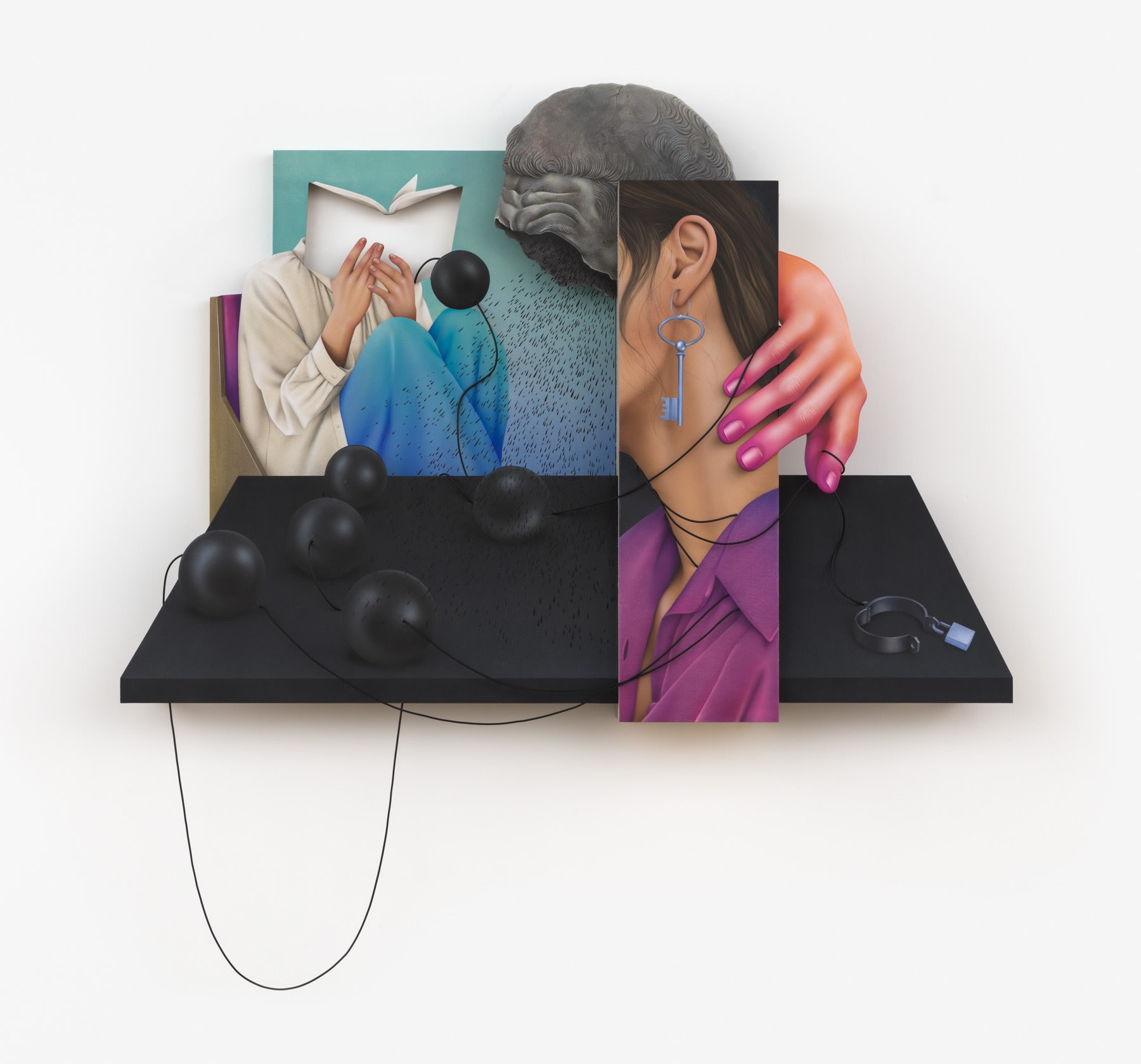
Arghavan Khosravi, Black Rain, 2021. Acrylic and cement on cotton canvas wrapped over shaped wood panel, wood cutout, elastic cord, 92 x 105 x 11 in. Photo courtesy of the artist.
OM: Like in most of your artworks, women have a dominant presence in your 2021 exhibition, “In Between Places.” What is different about these sculptural paintings in contrast to your previous bodies of work?
AK: In almost all of my paintings, I am depicting women. Maybe because in all of my paintings, I’m reflecting on my memories and life experiences in Iran. In those memories, the institutional and cultural barriers that constrained women's participation in the public sphere are very prominent. In the “In-Between Places”series, I was interested in incorporating a visual element that is consistent in almost all of the works. This visual element was the vertical rectangular panels with a cropped image of a female portrait or figure. The cropped portraits obscure the identity of these women and they become more like an example or representative of a larger group of people, rather than an individual person. Thus, the audience could identify each of these women through their own imagination or imagine themselves in each situation.
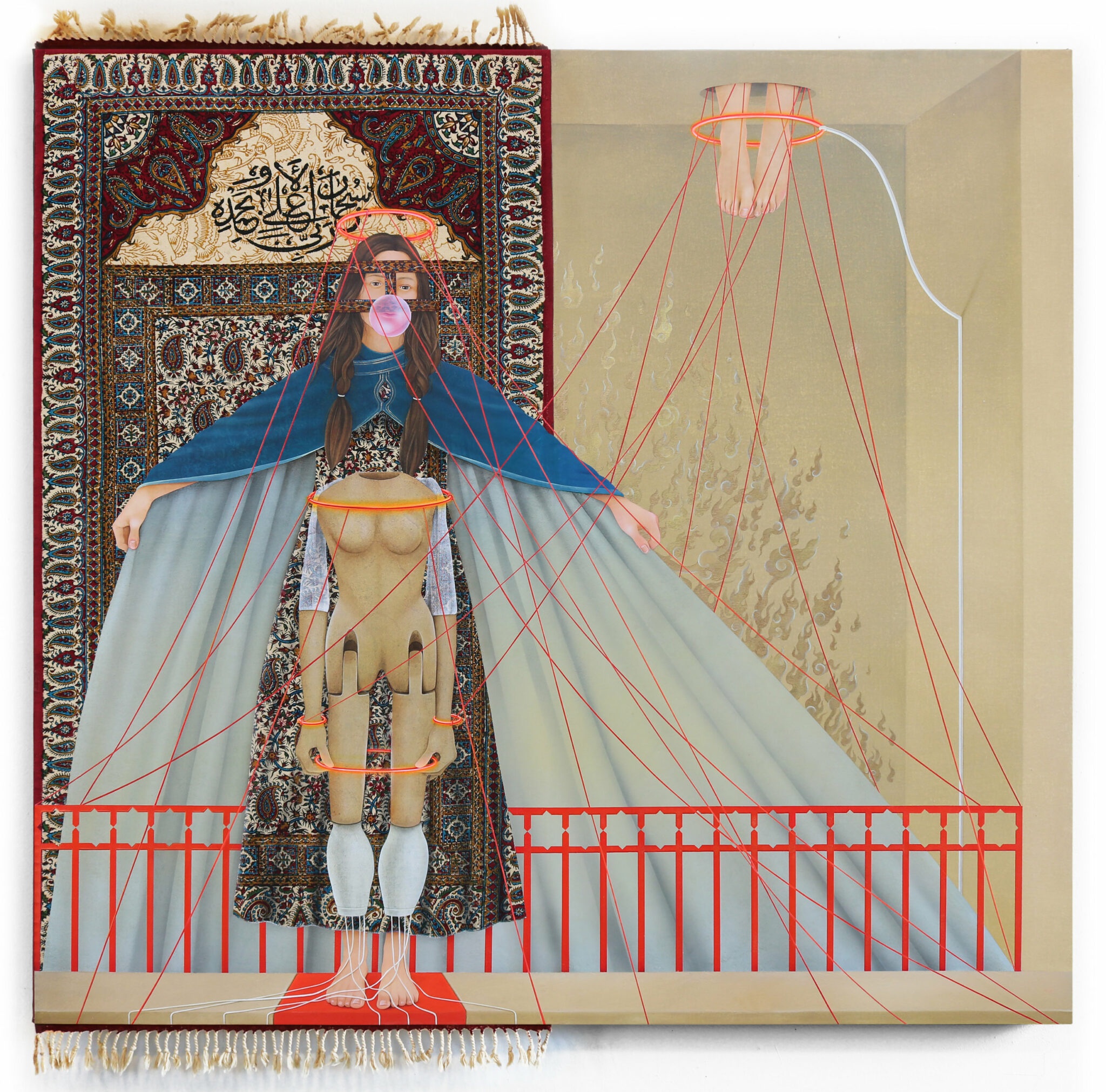
Arghavan Khosravi, Compulsory Halo, 2019. Acrylic on found wood block printed fabric (which is a praying mat) and cotton canvas mounted on wood panel, 48 × 45 × 2 in. Photo courtesy of the artist.
OM: You studied graphic design and illustration back in Iran. How did your Iranian art education shape the work you do now?
AK: In Iran, we had to decide very early (second year of high school) about our high school major, which would later limit our choices for the college major. At that point, although I was very interested in art and pretty good at it, 15-year-old me thought that art was something I should pursue on the side so I decided to choose mathematics to eventually become an engineer or something like that. Later on, in the last year of high school, I realized that I would like to pursue art as my career but still felt that fine art was something that I might not be able to build a career with and be financially dependent on. So, I decided to study graphic design which has both aspects of fine and applied art.
In graphic design, I learned about composition, color, and visual communication in general, which today are helpful to my painting practice. I think the skills and experiences I had in graphic design led me to approach painting from a slightly different perspective than if I was trained to be a painter in a more conventional way. So to some extent, it helped me develop my own painting and creative process. The same goes for illustration; it gave me a set of skills that are still present in my paintings, for example, the dominance of narrative and visual storytelling. So at this point, although I landed on painting later in my life, I don’t regret my choices and if I had the chance to go back in time, I would probably make similar decisions.
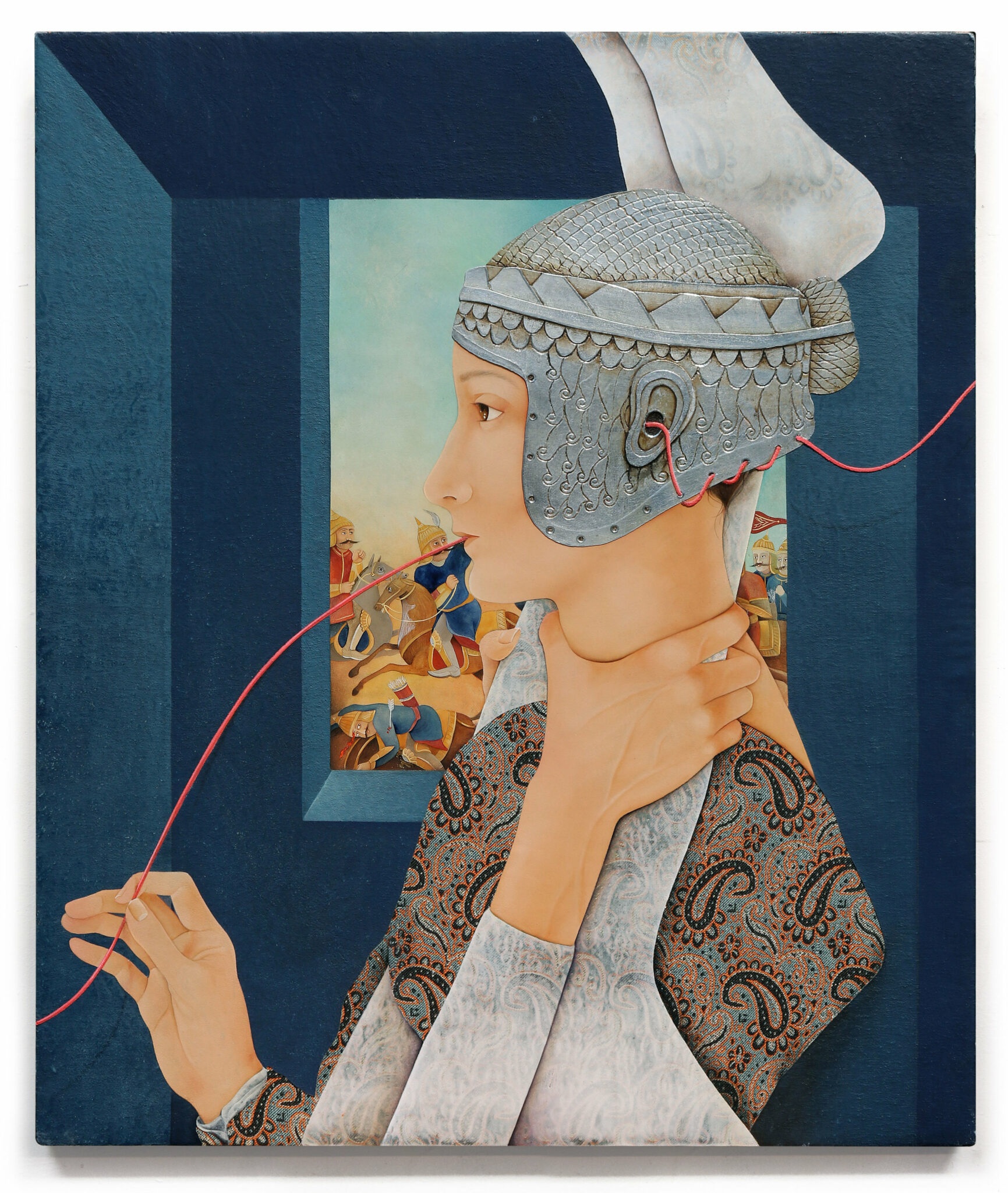
Arghavan Khosravi, History Is A State Of Mind, 2018. Acrylic and silver leaf on found woven patterned textile and linen on wood panel, 24 x 20 in. Photo courtesy of the artist.
OM: In your painting, “On Being a Woman,” there is a labyrinth of symbolism to unfold. What is the story behind it? Do you see yourself in this piece?
AK: In this piece, I was thinking about growing up and living in a patriarchal society. Under such circumstances, women are treated as if they are always doing something wrong and should be restricted within a boundary that the patriarchal (or religious) structure is imposing on them — like criminals. For instance, I remember I was once arrested on the streets of Tehran because the hijab I was forced to wear wasn't covering enough. I’m sure there are thousands of other women who share a similar experience. Placing the black rectangle in front of the figure's eyes in the painting is reflective of these concepts. It’s a familiar visual element associated with publishing criminal faces in the media.
The other metaphor I used in this painting is the colorful landscape. I often use these green and colorful landscapes as a symbol of hope, an ideal place, a utopia. (It is a metaphor you can find in Persian literature, too.) In these works where I’m thinking about women's rights issues and patriarchal societies, you can guess what I mean by an ideal place. But in this piece, the lively landscape is separated from the viewer with a curtain that has almost collapsed or has been torn down. You see a shadow behind the curtain and a figure’s hand, which suggests someone is standing behind the curtain and looking at us, but her face is missing. By situating the symbology behind the landscape, you can interpret more of each of these visual metaphors, within that given context.
OM: In “The Suspension,” we see a missile pointed at a woman’s face. Another woman is lying on her knees over a body, both figures pointed downward on a steep slope. This painting evokes the “rock and a hard place” predicament of the Iranian people whereby weapons, a means touted as contributing to the country’s security, are actually having the opposite effect and harming women, in particular.
AK: That is a very interesting and thoughtful read. In this piece, I was thinking about the feeling of uncertainty. I made this piece after months of home quarantine during the pandemic. Thus, the initial idea started from there but it also reflects on the current situation in Iran. Over the past few years, or even decades, Iranians have felt like they’re on the brink of war most of the time. For me, the feeling was like having a missile suspended in front of you and having no idea when it will start moving.
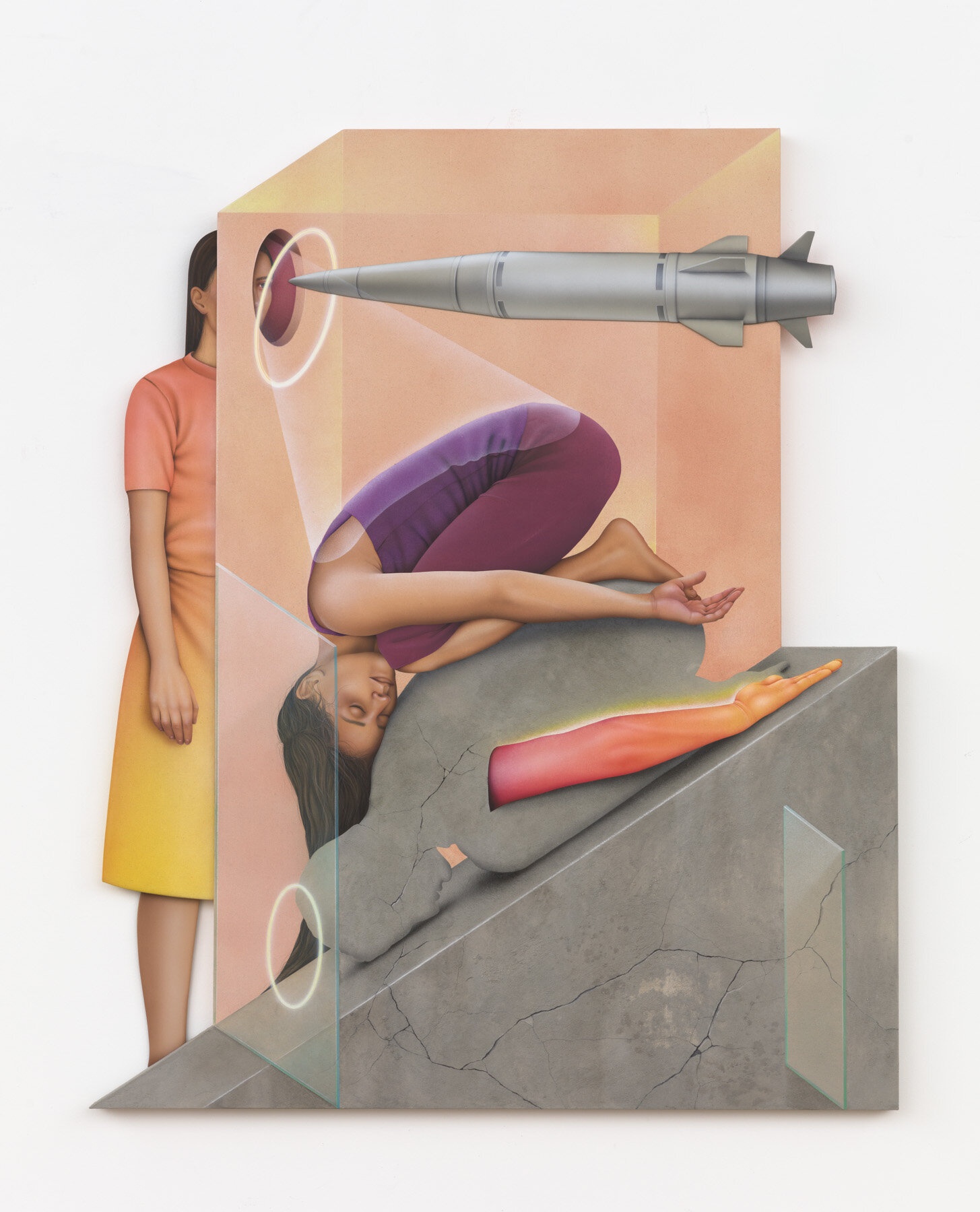
Arghavan Khosravi, The Suspension, 2021. Acrylic and cement on cotton canvas wrapped over shaped wood panel, wood cutout, 57 x 47 x 2 in. Photo courtesy of the artist.
OM: How has immigration to the U.S. impacted your art — both in terms of form and technique, as well as the subject matter you focus on?
AK: I came to the U.S. to study painting in graduate school. Before that, painting was never my main focus; it was something I would do in my spare time after my day job. Since I came here, painting became the center of my focus and my professional life totally changed. Every day I realize how right this decision was — both to immigrate here, where I can express myself freely without being concerned about any sort of censorship, and also to become a painter. Before that, in both graphic design and illustration, there had always been a client or publisher I had to listen to, and at the end of the day what I made only conveyed whatever message or ideas they wanted me to say.
On top of that, there was the censorship imposed by the government which did not leave me much room for self-expression. It was too much for me because my ambition was to express myself freely and say whatever I want to say in my work. That was the most satisfying thing I felt when I came to the US and switched to painting. During these years, during graduate school, I could design my own creative process and painting techniques which have been evolving ever since.
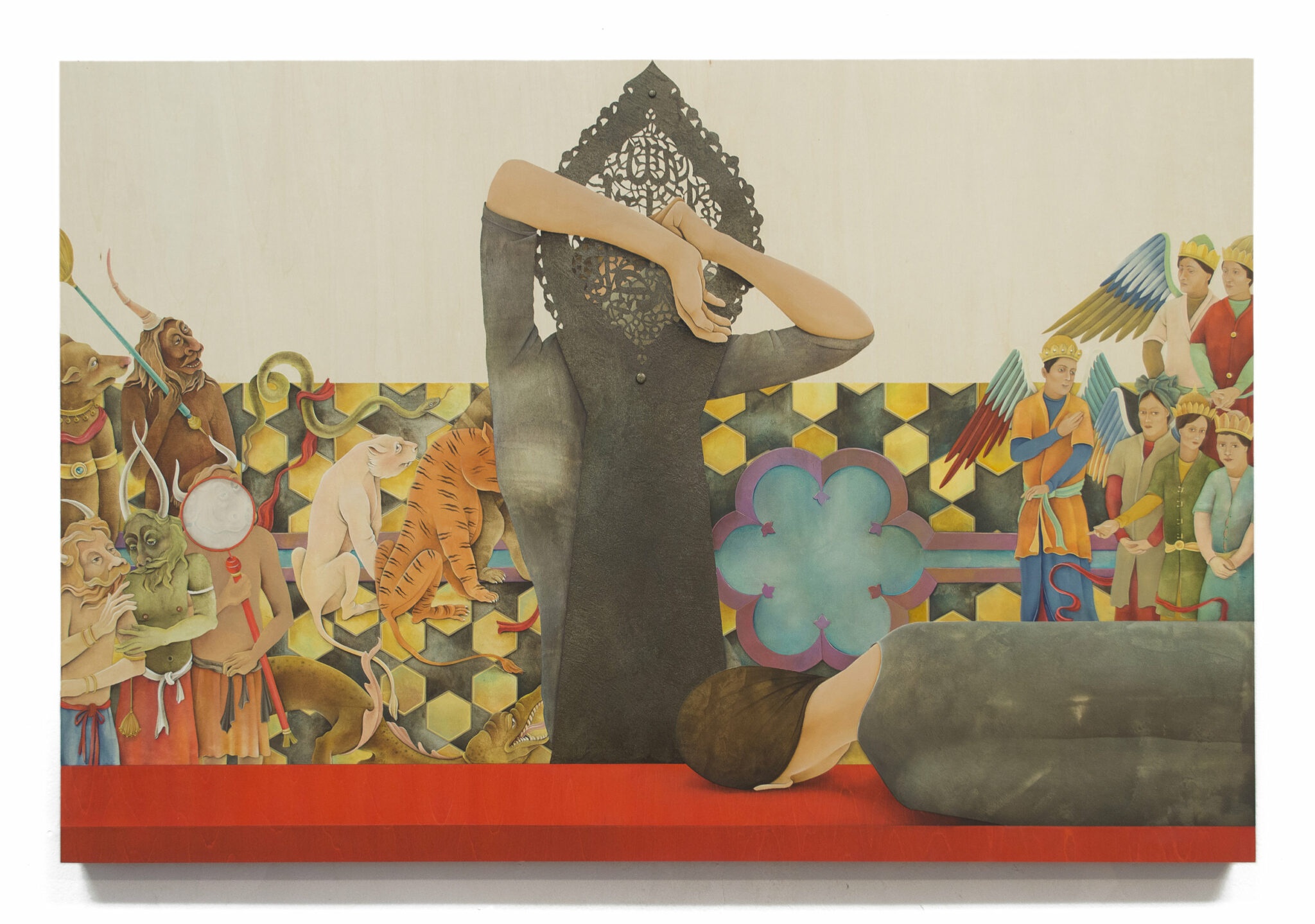
Arghavan Khosravi, The Limbo, 2018. Acrylic and metallic spray paint on raw bass wood panel, 24 x 36 in. Photo courtesy of the artist.
OM: Anyone looking at your extensive body of work can see that you are, beyond a sophisticated artist, also a storyteller. In this way, your work is evocative of Persian miniatures where the viewer must explore layers of meaning and interconnected elements throughout the paintings to understand the embedded, circular stories. What is the source of this storytelling style?
AK: Your observation is exactly on point and it’s very nice to hear that. Miniature painting, and more specifically Persian miniature painting, is one of my main sources of inspiration; whether it’s the way architecture is depicted in those paintings, the approach toward depicting language, the mesmerizing colors, or the way the figures’ form of expression is visible in their body language and poses, rather than in their face.
One of the other fascinating characteristics of these works, as you mentioned too, is that they have usually been made to accompany a story. I like to have a similar approach in my own work. I would like to load the paintings with symbols, visual metaphors, and codes that are layered in a way that hopefully invite the viewer to take a closer look and spend more time with the piece. It also allows the works to be accessible to different audiences coming from different walks of life and cultural backgrounds.
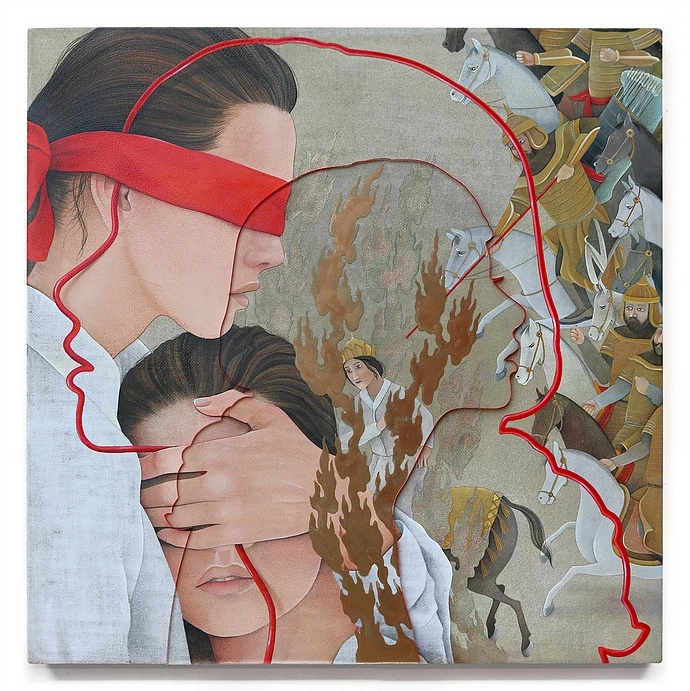
Arghavan Khosravi, Self-censorship Series 1, 2018. Acrylic and plexiglass on linen canvas on wood panel, 12 x 12 in. Photo courtesy of the artist.

